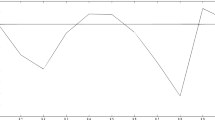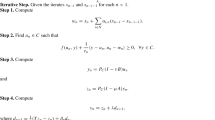Abstract
The present paper gives an alternative approximation method to find integrals of systems of ODEs using fuzzy transform (Fz-Tr). Especially, the new modified numerical approximation method to find the integral for a class of coupled systems of second-order ODEs (SOODEs) is introduced using Fz-Tr concept followed by numerical methods. This helps us to determine more approximate solution of SOODE. Using the proposed methodology, some examples are discussed and the error of approximation is observed.









Similar content being viewed by others
References
Ahmad M, De Baets B (2009) A predator–prey model with fuzzy initial populations. In: Proceeding of 13th IFSA world congress, pp 1311-1314 (6th EUSFLAT Conference, Lisbon, Portugal)
Ahmad M, Hasan M, De Baets B (2013) Analytical and numerical solutions of fuzzy differential equations. Inf Sci 236:156–167
Alikhani R, Zeinali M, Bahrami F, Shahmorad S, Perfilieva I (2017) Trigonometric FM-transform and its approximative properties. Soft Comput 21:3567–3577
ALKasasbeh H, Perfilieva I, Ahmad M, Yahya Z (2018a) New fuzzy numerical methods for solving Cauchy problems. Appl Syst Innov 1:15
ALKasasbeh H, Perfilieva I, Ahmad M, Yahya Z (2018b) New approximation methods based on fuzzy transform for solving SODEs: I. Appl Syst Innov 1:29
ALKasasbeh H, Perfilieva I, Ahmad M, Yahya Z (2018c) New approximation methods based on fuzzy transform for solving SODEs: II. Appl Syst Innov 1:30
Al-Omari A, Arnold J, Taha T, Schüttler H (2013a) Solving large nonlinear systems of first-order ordinary differential equations with hierarchical structure using multi-GPGPUs and an adaptive Runge–Kutta ODE solver. IEEE Access 1:770–777
Al-Omari A, Schuttler H, Arnold J, Taha T (2013b) Solving nonlinear systems of first order ordinary differential equations using a Galerkin finite element method. IEEE Access 1:408–417
Atkinson K, Han W, Stewart D (2009) Numerical solution of ordinary differential equations. Wiley, New York
Bede B, Rudas I (2011) Approximation properties of fuzzy transforms. Fuzzy Sets Syst 180:20–40
Chen W, Shen Y (2014) Approximate solution for a class of second-order ordinary differential equations by the fuzzy transform. J Intell Fuzzy Syst 27:73–82
Di Martino F, Sessa S (2017) Fuzzy transform prediction in spatial analysis and its application to demographic balance data. Soft Comput 21:3537–3550
Di Martino F, Sessa S (2018) A method based on extended fuzzy transforms to approximate fuzzy numbers in Mamadani fuzzy rule based system. Adv Fuzzy Syst, Article ID8458916, 16
Di Martino F, Sessa S (2019) Seasonal time series forecasting by F1-fuzzy transform. Special issue intelligent systems in sensor networks and internet of things. Axioms 19:3611
Di Martino F, Sessa S (2020) Fuzzy transforms for image processing and data analysis. Core concepts, processes and applications. Springer, Cham, p 217. https://doi.org/10.1007/978-3-030-44613-0
Di Martino F, Sessa S (2021) Attribute dependency data analysis for massive datasets by fuzzy transforms. Soft Comput. https://doi.org/10.1007/s00500-021-05760-y
Di Martino F, Loia V, Sessa S (2010) Fuzzy transforms method and attribute dependency in data analysis. Inf Sci 180:493–505
Di Martino F, Loia V, Sessa S (2011) Fuzzy transforms method in prediction data analysis. Fuzzy Sets Syst 180:146–163
Di Martino F, Sessa S, Perfilieva I (2017) First order fuzzy transform for image compression. J Signal Inf Process 8:178–194
Di Martino F, Perfilieva I, Sessa S (2021) A summary of F-transform techniques in data analysis. Electronics 10:1771. https://doi.org/10.3390/electronics10151771
Hurtik P, Perfilieva I (2017) A hybrid image compression algorithm based on JPEG and Fuzzy transform. In: Fuzzy systems (FUZZ-IEEE) (IEEE International conference on, Naples). https://doi.org/10.1109/FUZZ-IEEE.2017.8015614
Khastan A (2017) A new representation for inverse fuzzy transform and its application. Soft Comput 21:3503–3512
Khastan A, Perfilieva I, Alijani Z (2016) A new fuzzy approximation method to Cauchy problems by fuzzy transform. Fuzzy Sets Syst 288:75–95
Khastan A, Alijani Z, Perfilieva I (2017) Fuzzy transform to approximate solution of two-point boundary value problems. Math Methods Appl Sci 40:6147–6154
Li J, Zhao A (2016) Stability analysis of a non-autonomous Lotka–Volterra competition model with seasonal succession. Appl Math Modell 40:763–781
Matveev S, Smirnov A, Tyrtyshnikov E (2015) A fast numerical method for the Cauchy problem for the Smoluchowski equation. J Comput Phys 282:23–32
Molek V, Perfilieva I (2020) Deep learning and higher degree \(F\)-transforms: interpretable kernels before and after learning. Int J Comput Intell Syst 13(1):1404–1414. https://doi.org/10.2991/ijcis.d.200907.001
Mondal S, Roy T (2014) First order homogeneous ordinary differential equation with initial value as triangular intuitionistic fuzzy number. J Uncertain Math Sci 2014:1–17
Mondal S, Roy T (2015) System of differential equation with initial value as triangular intuitionistic fuzzy number and its application. Int J Appl Comput Math 1:449–474
Opanuga A, Edeki S, Okagbue H, Akinlabi G, Osheku A, Ajayi B (2014) On numerical solutions of systems of ordinary differential equations by numerical–analytical method. Appl Math Sci 8:8199–8207
Parapari H, Menhaj M (2016) Solving nonlinear ordinary differential equations using neural networks. In: Proceedings of the 2016 4th international conference on control, instrumentation, and automation (ICCIA), Qazvin, Iran, pp 351–355
Paul S, Mondal S, Bhattacharya P (2016) Numerical solution of Lotka–Volterra prey–predator model by using Runge–Kutta–Fehlberg method and Laplace–Adomian decomposition method. Alex Eng J 55:613–617
Perez J, Conesa M, Alhama I (2016) Solving ordinary differential equations by electrical analogy: a multidisciplinary teaching tool. Eur J Phys 37:065703
Perfilieva I (2004) Fuzzy transform: application to the reef growth problem. In: Fuzzy logic in geology. Academic Press, London, pp 275–300
Perfilieva I (2006) Fuzzy transforms: theory and applications. Fuzzy Sets Syst 157:993–1023
Perfilieva I (2017) Modeling with fuzzy transforms—a new tool of data mining and quantitative finance. In: 6th international conference on reliability, Infocom technologies and optimization (trends and future directions) (ICRITO), pp 16–21. https://doi.org/10.1109/ICRITO.2017.8342391
Perfilieva I, Hurtik P (Sept 2013) \(F\)-transform for image reduction. Czech-Japan Seminar on Data Analysis and Decision Making under Uncertainty
Perfilieva I, Kreinovich V (2011) Fuzzy transforms of higher order approximate derivatives: a theorem. Fuzzy Sets Syst 180:55–68
Perfilieva I, Kreinovich V (2013) \(F\)-transform in view of aggregation functions: aggregation functions in theory and in practise. Advances in intelligent systems and computing. Springer, Berlin, p 228. https://doi.org/10.1007/978-3-642-39165-1_37
Perfilieva I, Daňkováa M, Bede B (2011) Towards a higher degree \(F\)-transform. Fuzzy Sets Syst 180:3–19
Perfilieva I, Števuliáková P, Valášek R (2017) F-transform-based shooting method for nonlinear boundary value problems. Soft Comput 21:3493–3502. https://doi.org/10.1007/s00500-017-2543-5
Radi D, Sorini L, Stefanini L (2020) On the solution of ordinary, interval and fuzzy differential equations by use of \(F\)-transform. Axioms 9:15
Ramos H, Singh G, Kanwar V, Bhatia S (2017) An embedded 3(2) pair of nonlinear methods for solving first order initial-value ordinary differential systems. Numer Algorithms 75:509–529
Tomasiello S (2017a) A first investigation on the dynamics of two delayed neurons through fuzzy transform approximation. In: Proceedings of international conference on high performance computing simulation (HPCS), Genoa, Italy, 17–21 July, pp 460–465
Tomasiello S (2017b) An alternative use of fuzzy transform with application to a class of delay differential equations. Int J Comput Math 94(9):1719–1726
Vajgl M, Perfilieva I, Hodáková P (2012) Advanced \(F\)-transform-based image fusion. Adv Fuzzy Syst 9:125086. https://doi.org/10.1155/2012/125086
Yusufoğlu E, Erbas B (2008) He’s variational iteration method applied to the solution of the prey and predator problem with variable coefficients. Phys Lett A 372:3829–3835
Funding
There is no funding from any source.
Author information
Authors and Affiliations
Contributions
All the authors have equally contributed to the final version of the paper. All authors have read the manuscript.
Corresponding author
Ethics declarations
Conflict of interest
All authors declare that they have no conflict of interest.
Additional information
Communicated by Jose Alberto Cuminato.
Publisher's Note
Springer Nature remains neutral with regard to jurisdictional claims in published maps and institutional affiliations.
Rights and permissions
Springer Nature or its licensor (e.g. a society or other partner) holds exclusive rights to this article under a publishing agreement with the author(s) or other rightsholder(s); author self-archiving of the accepted manuscript version of this article is solely governed by the terms of such publishing agreement and applicable law.
About this article
Cite this article
Magadum, C.G., Bapat, M.S. An approximation method to solve coupled system ODEs of order second using fuzzy transform. Comp. Appl. Math. 41, 380 (2022). https://doi.org/10.1007/s40314-022-02091-y
Received:
Revised:
Accepted:
Published:
DOI: https://doi.org/10.1007/s40314-022-02091-y




